
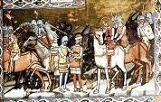
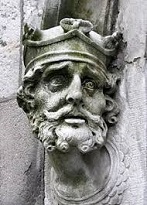
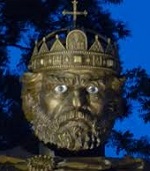








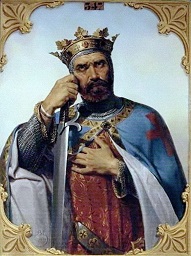
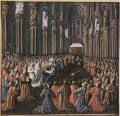
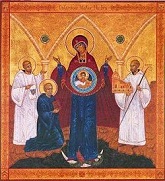


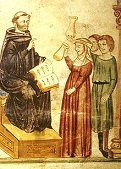






















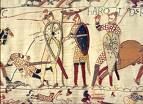






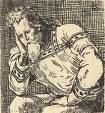


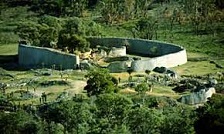
1000 World pop.: 200M-300M; Constantinople: 300K, Rome: 35K, Paris: 20K; the thriving Chinese Bei (Northern) Song Dynasty (960-1127) is the world's most populous empire; the Muslim Abbasid Caliphate (750-1258) and remnants of the Umayyad Caliphate (661-) thrive in Spain, N Africa, the Middle East, and C Asia; there are 45K Christians in Baghdad; early in this cent. W Europe develops its first urban society. India's share of global GDP: 28.9%, sliding to 24.4% in 1700, 16.1% in 1820, and 4.2% in 1950, rising to 7.1% in 2015. A third of world Christians still live in Asia, and a tenth in Africa; by the end of the 14th cent. they are virtually wiped out by Islamic persecution. The original myth of the female orgasm? This was the last year of the 10th cent. in the Julian Calendar as well as the last year of the first millennium, and was a leap year starting on Mon.; the papal chancery now dated all documents using the Anno Domini (A.D./B.C.) system for the Julian Calendar - perhaps they now can't cover up that the world has a long future ahead of it before (if ever) he comes baaack, but don't want the world to regress to the pagan state that existed before he arrived? The Terreur de l'An Mil (Millennium Fever) (MF) gives many in Christendom a big buzz, mainly in France, which used the Julian Calendar, and mainly among monks, since the clerks still used regnal years, although rumors spread to the gen. pop. The Medieval Climate Anomaly begins, bringing a warm climate; the sea level rises 0.5mm a year for the next four cents; Europe begins a period of optimal climate conditions for agriculture, producing large harvests until c. 1250 - good era for producing those legions of young unmarried stags who will go on military expeditions looking for the Three P's, poon, er, the Three B's? The Early Middle Ages end, and the High Middle Ages begin, with major changes in W European life, incl. the rise of medieval communes, the resurgence of city life, the appearance of the burgher class, the revival of long-distance trade with the Mediterranean, the founding of the first univs., the rediscovery of Roman law, and the beginnings of vernacular lit.; meanwhile the Byzantine Empire enjoys its Golden Age in Greece and Turkey. About this time italy is divided into Lombardy (Genoa), the Marquisate of Tuscany (Pisa), the Repub. of Venice, Romagna, Pentapolis, the Papal States (Rome), the Duchy of Spoleto, the Principality of Benevento, the Principality of Capua, the Principality of Salerno, and the Duchy of Amalfi, with the Byzantine Empire controlling the toe, heel, and back of the ankle; Sardinia and Corsica are disputed, and Muslims control the Emirate of Sicily (Syracuse). In this cent. Venetian aristocrats begin using hereditary surnames, and by the end of the cent. returning Crusaders spread the custom throughout Europe, incl. Anglo-Saxon England. In this cent. the failure of Christ to return causes him to go from being portrayed as "Christ triumphant" to "the Christ of pain", becoming his main act by the 13th cent. Please allow me to introduce myself, I'm a man of wealth and fame? On Mar. 11 after "Emperor of the World" HRE Otto III makes Rome the permanent residence of the HREs, then makes a pilgrimage to Aachen, where he opens his hero Charlemagne's Tomb, and finds him seated in a marble throne, which is used for the coronation of Holy Roman emperors for cents., then continues to Regensburg, Meissen, Magdeburg, and Gniezno (in Poland), and venerates the shrine of Adalbert, he attends the Congress of Gniezno (Gnesen) in Gniezno in WC Poland, held by Boleslav (Boleslaus) (Boleslaw) I Chobry (the Brave) (the Mighty) (the Great) (967-1025), setting up the independent archbishopric of Gniezo, with Radim Gaudentius (970-1020) as the first Polish archbishop - the heady power of the zero in the year one-zero-zero-zero, man this must be like being king of the world at the batting-1000 point in Christian history? Attila the Hun rolls over in his grave? On Mar. 27 Pope Sylvester II grants the title of king (apostolic majesty) to Hungarian ruler (St.) Stephen I (the Great) (969-1038), and appoints him papal vicar for his new Roman Catholic country, with a mission to kick Orthodox Christian and pagan butt, and he goes on to found St. Peter and St. Paul Monastery in Buda. On Sept. 9 Olaf I Tryggvason (b. 969) of Norway is killed in his ship Long Serpent by Svein Forkbeard (Sweyn I) of Denmark and Earl Eric, son of Earl Hakon in the naval Battle of Svolder (Svold) (Swold), giving Denmark control of part of Norway under King Cnut's Norwegian brother-in-law Earl Eric of Lade (d. 1015). Ethelred II the Unready of England finally gets ready and ravages Cumberland and Anglesey, then invades Normandy, getting his butt kicked by Duke Richard II the Good, and returning after signing a treaty. David III of Tao (Tayk) (b. 930), lord of the Armenian-Iberian borderlands is murdered by his nobles, and Byzantine emperor Basil II takes over his lands. Bohemia and Moravia are united. Castile is burned by the Muslims, and the pop. messed up medievally. Mahmud of Ghazni launches the first of 17 Expeditions into India across the Afghan frontier, kicking Indian butt, stealing everything that isn't nailed down (and that too), and slowly turning the Punjab region into a dependency while forcing conversion to Muslim or enslaving millions; by 1525 as many as 60M-80M are killed by Muslim invaders and rulers. The people of Capua oust their prince Adhemar, and invite Landulf di Sant'Agata (-1007), brother of Pandulf II the Old of Benevento to be their new prince. Burchard of Wurms (Worms) (-1025) becomes bishop of Wurms (Worms) (until 1025). A new millennium, a new kind of hog for the Hell's Angels? In this decade the Norwegian ex-Viking Normans, having settled in France and adopted Christianity and the French language, and abandoned their old Viking long ship pirate ways for PC cavalry warfare, seek to expand into S Italy and Sicily - now that they are PC? Early in this cent. the Saxons settle in Bristol (modern-day pop. 454K/1.0M) on the banks of the Avon River at its confluence with the Frome River, about 120 mi. W of London; they originally call it Bricg Stowe ("settlement by the bridge"); it receives a royal charter in 1155, going on to make it to the top three cities after London in tax receipts by the 13th cent. until it is surpassed by Birmingham, Manchester, and Liverpool during the Industrial Rev., becoming the launch point for exploration of North Am. by John Cabot in 1497, and a center for shipping African slaves to North Am. in 1700-1807, carrying 500K slaves on 2K ships. In this decade I-can-only-imagine Venice extends its rule to the Dalmatian coast and the Adriatic Sea, causing once-boss Aquileia to start shriveling down to the size of a small fishing village - go daddy dot com? Early in the decade the Khitans of Manchuria invade Korea (Koryo) for a 2nd time, but withdraw when their supply lines become overextended. Tiahuanaco in Bolivia is wiped out by invaders, but a few of the white settlers (of 500 years earlier) escape to the sea? In this cent. the Welsh still fail to achieve political unity, producing nearly 100 different rulers - those wild Celts still like to be hillbillies? In this cent. Greenland becomes part of the German diocese of Hamburg-Bremen, but doesn't get its own bishop until 1126. In this cent. German traders set up shop in the Baltic island of Gothland (Gotland) (Gottland) and in London. In this cent. Dunwich on the Suffolk coast of England 92 mi. NE of London and 9 mi. S of Southwold flourishes as the capital of the Kingdom of the East Angles, with a large port, naval base, two seats in parliament, and one-sixth the pop. of London; too bad, the fast-eroding coastline causes the pop. to dwindle, reaching a breaking point with a storm surge in 1286 and two great storms in 1287, reducing the pop. to 200 by modern times. In this cent. the Kingdom of Goryeo (Koryo) (founded in 918) builds a summer palace in the "Southern Capital", which becomes known as Seoul (modern-day pop. 10.1M/25.6M); in 1392 the new Joseon (Chosun) (Choson) Dynasty (ends 1897) moves its capital to Seoul. In this cent. the port city of Quanzhou, China becomes China's major port for foreign traders until the 14th cent., becoming known for its mosques incl. the 13th cent. Qingjing Mosque. In this cent. the O'Shaughnessy sept becomes dominant in S Ui Fiachra. In this cent. the Wari civilization in the Andean highlands declines, making way for the Inca. In this cent. C.E. Bantu-speaking peoples evolve the Zimbabwe culture at the Great Zimbabwe royal palace in Africa near Lake Mutirikwe (ends 15th cent.) In the 11th cent. the tall warrior-dominated Bantu-speaking Hutu arrive in modern-day Rwanda and Burundi, soon outnumbering the native Twa and Tutsi. In this cent. nomadic Berber (Zenaga) tribes from Mauretania begin moving S into the valleys of the Gambia and Casamance Rivers on the W bulge of Africa, meeting African tribes from the S and forming the country of Senegal. In this cent. potatoes and corn are planted in Peru. In this cent. the ruined seaport of Brindisi in S Italy is rebuilt as a port of embarkation for Crusaders. About this time there are 46 monasteries on Mt. Athos in Greece, where women aren't allowed; down to 20 by modern times. In this cent. the U. of Parma in Italy is founded. In this cent. Walter Giffard, Norman vassal of the king (William I's standardbearer at the 1066 Batttle of Hastings) becomes the first earl of Buckingham. In this cent. the House of Wettin is founded, acquiring Wettin Castle in Wettin on the Saale River in Saxony-Anhalt, becoming the ancestor of many Euro dynasties incl. the dukes of Saxe-Coburg-Gotha, British Prince Albert, and Edward VII of Britain; in 1917 the British royal family changes its name to Windsor. Modern-day Norwegians claim that the city of Oslo is founded this year. In this cent. Dhaka, Bangladesh is founded. Early in this cent. the town of Lille (Ryssel) in Nord, France (66 mi. SE of Calais) (named after the L'Isle Castle) is founded by the counts of Flanders, becoming a manufacturing center and the medieval capital of Flanders. In this cent. the Mayan civilization in Yucatan reaches its zenith. In this cent. the tribes in the N highlands of Ecuador form the kingdom of Quito ("Middle of the World"). The Fremont People on the Colorado Plateau mysteriously vanish after 3K years. In this cent. the 3K-5K inhabitants of Mesa Verde move into adobe villages, then by the end of the cent. move under the rim. About this time Arabic speakers in India change the pronunciation of the word "Sinhu" (people living E of the Indus River) to "Hindu". In this decade Arabs and Jews begin arriving in backwards Germany to become court physicians. In this cent. Islam's scholarly groups begin a fierce factional rivalry, incl. bloody street battles, which lasts until the 13th cent. In this cent. the village of Alpbach in W Austria in the Tyrol is first settled; its parish church is dedicated to St. Oswald of Northumbria. Early in this cent. the secret Muslim Druse (Druze) sect in Syria and Lebanon is founded by Ismail al-Darasi (al-Darazi) (al-Durzi) (-1020) ("the tailor"). King Gryffull ab Aynam of North Wales reforms the order of Welsh bards, separating the professions of bard and minstrel. In this cent. the Arabs introduce the lemon plant to Sicily and Spain. In this cent. French and other European men begin to wear their hair in one or two cues, bound up with ribbons and lying over the shoulders from the back - the original pull my cue trick? Pottery made in Guatemala in this cent. contains the first pictorial record of smoking tobacco; the Mayan term for smoking is "sik'ar". About this time the Chateau de Goulaine vineyard in the Loire Valley of France is founded. About this time the Fonderia Pontificia Marinelli bell foundry is founded in Italy. About this time the Roman Catholic Diocese of Kolobrzeg in Poland is founded by Bishop Reinbern (-1015). In this cent. the Frisians of the Netherlands begin building dykes. About this time Indian Hindu Shaivist sage Abhinavagupta (Sansk. "authoritative") (950-1016) flourishes in Kashmir, originating the theory of rasa (vital juice or sap) in his masterpiece Tantraloka (Sansk. "Light on Tantra"), which synthesizes the 64 monistic agamas (traditions). Architecture: A wave of new church-building sweeps Christendom starting this year, due to you guessed it. Otto II begins the Basilica of San Bartolomeo all'Isola in Rome to host the relics of St. Bartholomew. The Basilica San Pietro de' Cassinensi in Perugia, Italy is built in this cent. In this cent. the Bridge of Ten Thousand Ages in Foochow (Fuzhou), China is built. The Shiwa Temple in Prambanan, Java is founded in this cent. Cahokia Mounds across the Mississippi River from modern-day St. Louis are built in this cent., incl. 100-ft.-high Monks Mound, the largest prehistoric earthwork in the Americas. Inventions: In this cent. Persians begin mixing chromium into their steel. In this cent. gears become common in the Arab world, used with water wheels and water clocks. In this cent. the Welsh Fidicula, AKA Crwth (pr. "CROOTH") (crowd) (crouth) (cruit) (chorus) (crotta) (rote) (from the Welsh word meaning a hump?), a type bowed of lyre and a forerunner of the modern violin is invented; the names Crowder, Crowther, MacWhirter and MacWhorter denote crwth players - far from the madding crwths, look it up in the Guinness Book of Records? About this time Arab brain man Alhazen (Ibn Al-Haytham) (965-1039) invents the Camera Obscura (pinhole camera), and reverses Aristotle, correctly claiming that light comes from the object seen into the eye and not vice-versa. In this cent. the people of coastal Ecuador learn to smelt platinum to make small beads, although how their method of achieving high temps is unknown. According to chronicler William of Malmesbury Abbey in England, fellow monk Eilmer (981-1061) tries to fly by attaching wings to his arms and legs to form a tailless glider, and launches himself from a tower, flying 200m (660 ft.) before crashing and breaking both legs. About this time Euro scribes invent the letter W (also written UU). In this cent. walrus ivory chess pieces are made on the Isle of Lewis in the Outer Hebrides (Scotland), and rediscovered in the early 19th cent., becoming the earliest known chess pieces. Science: In this cent. a calendar with a 360-day year divided into 12 mo. of 27-28 days, with an extra month added at regular intervals is introduced in India. In this cent. a 7-day week is introduced to China by Persians or C Asian merchants, superseding the 10-day week. In this cent. Chinese scholars decide that not only the Moon but the Sun has a role in controlling tides. In this decade Persian superbrain Avicenna (Ibn Sina) (980-1037) claims two causes for mountains: "Either they are the effects of upheavals of the crust of the Earth, or they are the effect of water, which cuts itself a new route and denudes the valleys." Inventions: The 3-Field System is adopted in Europe, becoming the hat trick for a thousand years of progress out of the Dark Ages. Nonfiction: Abu al-Biruni (973-1048), Vestiges of the Past (Chronology of Ancient Nations) (Al-Athar al-Baqiyah fi Qanun al-Khaliyah); the calendars and festivals of various religions, trying for objectivity; "We must clear our minds... from all causes that blind people to the truth - old custom, party spirit, personal rivalry or passion, the desire for influence." Poetry: About this time the Anglo-Saxon Christian poem The Dream of the Rood (Crucifix) is written in Britain, preserved in the Vercelli Book, written late in this cent. Fiction: Diary of a Mayfly (Kagerofu no Nikki) is written by an anon. Japanese woman. In this cent. Gregorian monk Euthymios writes The Legend of Barlaam and Josaphat, about Christian saints who allegedly lived in India in the 3rd or 4th cent. C.E. but is really a ripoff of the story of Buddha; it gets mistakenly attributed to 7th cent. writer John of Damascus. Sei Shonagon, Makura no Soshi (The Pillow Book) (1000-1015); diary of a woman at the imperial Japanese court. Music: The Winchester Troper is composed in Britain, becoming the oldest large collection of 2-part music in Europe. it also contains the liturgical drama "Quem quaeritis", becoming the oldest surviving medieval play with music. Births: Muslim Buyid ruler of Kerman (1012-28) Qawam al-Daula (al-Dawla) (Au'l-Fawaris) (d. 1028) in Apr. French duke of Normandy #5 (1027-35) Robert II (I) (the Devil) (le Diable) (the Magnificent) (d. 1035) on June 22; son of Richard II the Good (963-1027) and Judith of Brittany (982-1017); father of bastards William the Conqueror (1026-87) and Adelaide of Normandy (1026-90) by Herleva, daughter of Falais tanner Fulbert. Norman count of Brionne and Eu Gilbert (Giselbert Crispin (d. 1040); son of Count Geoffrey of Eu (962-1010); father of Ritchard fitz Gilbert (1034-90) and Baldwin fitz Gilbert (-1090); guardian of William I. French duke of Upper Lorraine (1047-8) Adalbert (1000-1048); son of Gerhard II de Bouzonville, count of Metz and Gisela. Roman Byzantine emperor #145 (1042-55) Constantine IX Monomachus (Monomachos) (d. 1055) in Constantinople; husband (1942-) of Empress Zoe. Greek patriarch of Constantinople (1043-58) (author of the Great Schism) Michael I Cerularius (Caerularius) (Kerularios) (d. 1058). Arab rhetorician Ibn Rashiq (d. 1070). German archbishop of Bremen-Hamburg (1043-72) ("Vicar of the North") Adalbert (Adelbert) (Albert) I (d. 1072) in Goseck Castle, Hassegau, Saxony; son of Count Friedrich von Goseck, regent of HRE Henry IV, and Agnes of Weimar. French scholastic theologian Berengar (Berengarius) of Tours (d. 1088) in Tours. English monk Gamel de Spofforth (d. ?); father of Gamelbar de Spofforth (1037-?). Deaths: German nun Roswitha of Gandersheim (b. 935), leaving Six Plays of Roswitha of Gandersheim, and Carmen de Gestis Ottonis about her patrons Otto I-III. Norwegian (995-1000) king Olaf I Tryggvason (b. 969) on Sept. 9 (KIA). English queen consort (964-75) Aelfthryth (Elfrida) (b. 945) on Nov. 17; wife of Edgar (943-75). Spanish king Garcia IV of Pamplona (b. ?). Persian astronomer Al-Khujandi (b. ?). Toltec ruler Tlilcoatzin (b. ?).

1001 On Feb. 6 Count Gregory I of Tusculum (d. 1012) is named head of the Roman Repub. after leading a revolt against HRE Otto III and expelling the Crescentii; too bad, the latter return to power next year and expel him. On Dec. 25 (Christmas Day) (St.) Stephen I (the Great) (969-1038) of Hungary is crowned by HRE Otto III with a crown sent by Pope Sylvester II - put the maximum-bridge-builder-to-God's magic passkey on and you're set? The Byzantines under Basil II renew their campaign against Bulgarian khan Samuel I, who rules from the Adriatic to the Black Sea, and was raiding into C Greece. Sancho III the Great of Navarre unites with Navarre and begins the conquest of the kingdom of Leon (ends 1035). HRE Otto III appoints Werner I (978-1028), son of Lanzelin of Altenburg (-991) as bishop of Strasbourg (until 1028); he and his brothers Rudolph I (-1063) and Count Radbot of Klettgau (985-1045) are the first members of the all-new-ugly-betty House of Hapsburg (Habsburg) (Ausria). Brian Boru leads his army from Kincora to Athlone on the Shannon River S of Lough Ree in C Ireland to attend a gathering. After Icelandic Viking anything-goes-man Leif Ericson (Ericsson) (970-1020), son of Erik the Red buys Bjarni Herjulfson's ship (knarr) and sails with a 35-man crew from Greenland in a SW direction, he runs into North Am., first at Baffin Island, which he calls Helluland ("land of flat stones"), then Labrador, which he calls Markland ("land of forests"), and finally Newfoundland, which he calls Vinland the Good ("land of grapes/berries/meadows"), a place where wild grapes and wheat are seen growing; they winter there, building a village of "big houses", encountering the Beothuk people; in 1960 Helge Ingstad finds evidence of Vinland in L'Anse aux Meadows (Fr. "L'Anse-aux-Meduses" = jellyfish cove) in Newfoundland; did they bring back native women? Architecture: Kaiyuan Temple in Dingzhou, China is begun (finished in 1055). The domed cruciform Great Cathedral of Ani in Armenia (E Turkey) is completed in the reign of Gagik I (d. 1020); in 1319 an earthquake collapses the dome; in 1988 another earthquake collapses the NW corner. Births: English earl of Wessex (1019-53) Godwin of Wessex (d. 1053) in Sussex; father of Earl Sweyn of Herefordshire, Harold II Godwinson (1022-66), Earl Tostig of Northumbria, Queen Edith of Wessex (1029-75) (wife of Edward the Confessor), Earl Gyrth of East Anglia, Earl Leofwine of Kent, and Wulfnoth. Arab Abbasid caliph (1031-75) (Sunni Muslim) Al-Qa'im (d. 1075); son of Al-Qadir (991-1031); husband (1056-) of Arslan Khatun Khadija, son of Chaghri Beg (989-1060).
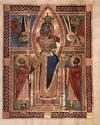

1002 On Jan. 24 Otto III (b. 980) dies, and after a struggle is succeeded as German king by his 2nd cousin (son of Duke Henry II the Wrangler, and great-grandson of Henry the Fowler) (St.) Henry II (the Saint) (973-1024), the 5th and last Saxon king of Germany; on his orders Otto III is buried beside Charlemagne in Aachen; Otto of Worms (-1004), who lost the duchy of Carinthia in 978 withdraws from the election in return for receiving it back. In the summer Cordoban emir Hajib al-Mansur (Almanzor) (b. 938) captures Caceres (Cáceres), then dies of illness on Aug. 8 in Castle Calatanazor as he is preparing to cross the Pyrenees, and his son Abd al-Malik al-Muzaffar (the Victorious) (-1008) becomes emir of Cordoba (until 1008), after which the Cordovan caliphate begins disintegrating. The Danish Pearl Harbor? On Nov. 15 (St. Brice's Day), by order of King Ethelred II the Unready, Redeless, and Devoid of Counsel, thousands of Danish settlers are massacred around Britain, incl. the sister of Svein Forkbeard, pissing the later off; anxious for alliances to help fight the devilish Danes Ethelred II marries Emma (Aelfgifu) of Normandy (985-1052), sister of Duke Richard II the Good of Normandy, giving Normandy a future claim on the English throne - big mistake? Irish high king Brian Boru defeats the Norse. St. Stephen I of Hungary defeats an anti-Christian revolt in Transylvania - run secretly by Dracula? The Byzantines under Basil II defeat the Bulgarians at the Battle of Vidin and regain Moesia. Vrsovichi (Vrsovici) nobles organize a revolt against weak Bohemian duke Boleslaus III the Red-Eyed, who flees to the protection of Henry I of Austria in Germany, who at first arrests them releases him and promises support; meanwhile Boleslaus' alcoholic kinsman Vladivoj (981-1003) becomes duke of Bohemia (until Jan. 1003). The city of Erlangen in Bavaria on the Regnitz River 11 mi. NW of Nuremberg (modern-day pop. 110K) is first mentioned under the name Villa Erlangon; in 1361 it is acquired by HRE Charles IV, who makes it part of Czech.; in 1364 a city is built near the village, which in 1374 is granted its own mint, and in 1398 is granted municipal rights by Wenceslaus IV of Bohemia; in 1402 it is acquired by the House of Hohenzollern as part of the Principality of Brandenburg-Kulmbach (Brandenburg-Bayreuth starting in 1603); in 1810 it is acquired by the kingdom of Bavaria; in 1686 the first French Huguenots fleeing persecution arrive, and margrave Christian Ernst of Brandenburg-Bayreuth assigns the land to them and builds Neustadt for them; in 1706 the old town burns down, and is rebuilt, and in 1812 the two towns merge. Architecture: The 3-naved buttressed basilica St. Paul's Chapter Church in Worms is built by Bishop Burchard. Births: Bohemian Premyslid duke (1035-) ("the Bohemian Achilles") Bretislaus (Bretislav) I (d. 1055); son of Oldrich and Bozena; kidnaps his wife Judith of Schweinfurt in 1119 from a monastery, and marries her in 1030; father of Vladislav II (-1092), Spitigniev (Spytihnev) (1031-61), Conrad I (-1092), and Jaromir (-1088). Roman Byzantine emperor #152 (1078-81) Nicephorus III Botaniates (Nikephoros III Botaneiates) (d. 1081); descended from the Phokas family. Deaths: Spanish Muslim statesman-gen. Al-Mansur (Almanzor) (b. 938) on Aug. 8. German HRE Otto III (b. 980) on Jan. 24 in Paterno; buried near Charlemagne, whose body he had dug up to pray before.


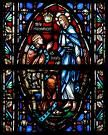
1003 On Feb. 9 after Vladivoj drinks himself to death, Boleslaus III is restored as duke of Bohemia with the support of Boleslav of Poland, causing his brothers Jaromir (whom he castrates) and Oldrich to flee to Merseburg, Germany under the protection of Henry II, but after he orders the Vrsovici nobles massacred at Vysehrad on the Vlata River during Lent, slaying his own son-in-law with his sword, Boleslav hears about it and gets pissed, then invites him to a castle and has him blinded and imprisoned, and takes over Bohemia, declaring himself duke; Boleslaus dies in captivity 34 years later; meanwhile Jaromir promises to hold Bohemia as a vassal of Henry II, placing it within the jurisdiction of the HRE. Early in the year with pesky Al-Mansur out of the way, Count Ramon Borrell of Barcelona leads an alliance of Catalonian counts to defeat a 17K-man force from the Caliphate of Cordoba at the Battle of Tora (Torŕ) at Tora, Lleida, causing Al-Mansur's son Abd al-Malik to raid his county to show he can fill daddy's shoes, and capture his brother Ermengol I of Urgell, imprisoning him in Albesa until a ransom is paid; on Feb. 25 after the Cordobans retreat to their own territory, the Battle of Albesa near Balaguer sees the united Christian forces of Catalonia lose Bishop Berngar of Elne, while the Cordobans lose Said bin Musa of Elvira. On May 12 Pope (since 999) Sylvester II (Gerbert of Aurillac) (b. 946) dies; because he is learned and has studied with the Muslim Moors he is regarded by the common people as a magician in league with the Devil, e.g., he is said to have tried to impose the Arabic (really Hindu) number system on Christians, incl. the newfangled zero, and to have invented the pendulum clock (that newfangled zero must have seemed groovy to the worldly, and pure terror to the pious?); on June 13 Crescentius II' son John gets Pope (#141) John XVII (-1003) elected, but he dies on Nov. 6.; he then gets Pope (#142) (St.) John XVIII (-1009) elected next Jan. The Byzantines under Basil II raid Macedonia and capture Skopje (Scopje) from the Bulgarians; in 2004 the Skopje Border Stone of Samuel is discovered near Petrich, reading "Samuel the Bulgarian Autocrat", pissing-off the citizens of Skopje, who had been claiming he was Macedonian. The Danes under Sweyn land in Britain, and attack Oxford, Exeter, Norwich et al. Count Adelfer of Avellino leads a rebellion against Prince Pandulf II the Old of Benevento, and ousts him and his son, but they make a comeback in 1005. Kung Fu master "White Eyebrow Priest" Pai Mei avenges an insult by massacring 60 eagle claw Kung-Fu Shao Lin monks, introducing the "Five Finger Palm Exploding Heart Technique", a single blow so powerful that the victim takes five steps and then his heart explodes :) (Quentin Tarantino). Births: English (penultimate Anglo-Saxon) king #19 (1042-66) Edward III the Confessor (d. 1066); son of Ethelred II the Unready (968-1016) and 2nd wife Emma of Normandy; half-brother of Edmund II Ironside (988-1016); half Anglo-Saxon and half Norman; raised as a Norman; feast day: Oct. 13. Deaths: Greek Byzantine monk St. Athanasios of Trebizond (b. 920) on Mount Athos; killed when the cupola of his church collapses. Norwegian explorer Erik the Red (b. 950) in Iceland (plague).



1004 German King Henry II goes on his first Italian campaign, defeats Ardoin, and is crowned king of Lombardy in Pavia; he then begins a war with Boleslav I of Poland over his acquisition of Lusatia and Silesia on the Polish border (ends 1018), and drives him out of Bohemia, allowing his 2nd son Jaromir (-1035) to occupy Prague and declare himself the new duke (until 1012), although Boleslav still holds Moravia, Silesia and Lusatia. Duke Otto I of Worms (brother of Pope Gregory V) dies, and his 3rd son Conrad I (975-1011) succeeds as duke of Carinthia (until 1011). After King (since 994) Garcia Sanchez II the Trembler died in 1000, his eldest son Sancho III Garces (El Mayor) (the Great) (the Large) (985-1035) becomes king of Pamplona (incl. Aragon) (until 1035), and sues Cordoba for peace; he spends his career uniting the Spanish kingdoms, adding the counties of Sobrarbe in 1015, Ribagorza in 1018, and Cea in 1030. The Saracens sack Pisa - I prefer mine in a cardboard box? China becomes tributary to the Tungusic Khitans, paying 100K oz. of silver and 200K bolts of silk. Rajaraja Chola I of S India finishes conquering Ceylon (Sri Lanka), funneling Singhalese revenues to his baroque Dravidian Great Pagoda of Rajarajesvara in Tanjore, and endowing a Buddhist monastery in Negapatam built by a king of Sumatra (Srivijaya). Leif Ericsson returns to Vinland, and is given the honorary name of Leif the Lucky; he gives his ship to his brother Thorvald Ericsson (Torvald Eiriksson) (-1005) (the Unlucky?), who leaves for Vinland in the fall. Architecture: Against episcopal objections Henry II founds the bishopric of Bamberg, building the Romanesque Bamberg Cathedral (finished in 1012), and richly endowing it as a German outpost against the pesky Slavs, beginning the anti-Slav prejudice of the "pure Aryan" Germans that culminates in the Nazi atrocities of WWII?; the cathedral later houses his tomb. Births: Spanish count #2 of Urgell (1010-38) Ermengol (Armengol) II (the Pilgrim) (d. 1038); son of Ermengol I (974-1010). Islamic Isma'ili (Assassin) theologian-poet Nasir-i Khusraw (d. 1008) in Balkh.


1005 I'm through with you Snowflake, it's time to say goodbye to your fat pants? In the summer while exploring the St. Lawrence Region, Thorvald and his crew attack a band of Skraelings (skrellings) (Indians), killing eight; the natives retaliate by ambushing them and killing Thorvald, making him the first white Euro killed in North Am.? On Nov. 16 Aelfric of Abingdon dies, and Winchester bishop (St.) Aelfheah (Elphege) (Alfege) (Godwine) (954-1012) becomes Canterbury archbishop #29 (until Apr. 19, 1012). There's a new sheriff in town? Malcolm II (the Aggressor) (the Destroyer) (980-1034) defeats and kills Kenneth III and his son Giric in Monzievaird in Strathearn, and becomes king of lily-white Alba (Scotland) (until Nov. 25, 1034), becoming the king of ruthless as he imposes his authority over the Scottish mainland, extends the borders far to the S, and keeps a check on his Moray kinsmen via alliances with the Norse rulers of Orkney; at first three kingdoms share Scotland: Alba in the N, Lothian in the SE, and Strathclyde in the SW. Irish Ard Ri (high king) Brian Boru (Boruma) (940-1014) of Munster is declared emperor of the Irish in Armagh. The Byzantines under Basil II recover Durres (Durazzo) (Dyrrachion) in S Albania from the Bulgarians with the help of the Chryselioi; too bad, the Byzantines hit a wall and fail to make any significant gains for the next several years (until 1014). Le Hoan dies, and Le Long Dinh (Le Ngoa Trieu) (986-1009), "the reclining emperor" becomes king of Vietnam (until 1009). Aelfric the Grammarian (the Homilist) of Eynsham (Cerne) (955-1020) becomes abbot of Eynsham, England, going on to write Letter to the Monks of Eynsham, Introduction to the Old and New Testament (1008), et al., reforming the language of Alfred the Great and replacing it with Late Wset Saxon. Islington in C London starts out as a manor named Giseldone, later (1062) Gislandune (Gisla's Dun or Hill), which changes to Isledon until the mid-17th cent. Births: Spanish count of Barcelona (1018-35) Berenguer Ramon (Berengar Raymond) I (the Crooked) (the Hunchback) (d. 1035); son of Raymond Borrell and Ermesinde of Carcassonne (972-1057); father of Ramon Berenguer I (1035-76). Egyptian Fatimid caliph #7 (1021-1036) (Shiite Muslim) Ali az-Zahir (Abu'l Hasan ?Ali az-Zahir li A'zaz li Din-illah) (d. 1036) on June 20; son of Al-Hakim bi Amr al-Lah (985-1021). Scottish king (1040-57) Macbeth (MacBeth) (Macbethad) (d. 1057); cousin of Malcolm II; husband of Gruoch (Lady Macbeth), daughter of Gillacomgain and granddaughter of Kenneth Mac Duib, son of King Dub. Roman Byzantine emperor #148 (1057-9) Isaac I Comnenus (Komnenos) (d. 1061); founder of the Comnenus Dynasty (1081-1185). English archbishop of Canterbury (1070-89) Lanfranc (d. 1089) in Pavia, Italy.
1006 Malcolm II launches a plundering raid into N England, but his army is routed in the Battle of Durham, causing his men to go home without booty, hurting the new king's prestige; meanwhile Brian Boru adopts the title of "Emperor of the Gael" to signal to Malcolm II that he is the #1 Gaelic king. Rudolph III of Burgundy appoints Henry II as his heir, leading to unrest and a revolt led by Baldwin of Flanders (ends 1007); Robert II the Pious of France allies with Henry II. Muslims settle in NW India - where the Hindus welcome the Religion of Peace? Suryavarman I (-1050) becomes king of Angkor (Cambodia), extending his kingdom to the N and W. The Book of Kells is stolen from Kells, Ireland, and is recovered 2 mo. and 20 days later buried under sod, with its cover of jewel-studded gold gone. Science: A magnitude 9 supernova is observed in the constellation Lupus, becoming the brightest known. Births: Norman duke Waldern (Waldonius), 1st Lord (Count) of Saint-Clair (d. 1047) (d. 1057?); nephew of duke Richard II; father of William Sinclair, 1st baron of Rosslyn (1028-70). Roman Byzantine emperor #149 (1059-67) Constantine X Ducas (Doukas) (d. 1067).


1007 English King Ethelred II pays 30K pounds in Danegeld to gain two years of freedom from attacks and ransacking. The Viking settlers abandon Vinland to the pesky Skraelings, and Leif Ericson's dead brother Thorvald is returned to him in Greenland for burial - where do all these Skraelings come from on such a small island, duh? Baldwin of Flanders is defeated in Burgundy. Malcolm II marries one of his daughters to Jarl Sigurd the Mighty (-1014) of Orkney, whose realm stretches from Dornoch Firth and Shetland to the Hebrides, securing Malcolm's N frontiers and leaving him free to concentrate on the S. Landulf di Sant'Agata dies, and his brother Pandulf III the Old of Benevento succeeds as prince of Capua, reuniting them for the first time since 981. Elvira of Castile becomes a nun, and Alfonso V assumes personal rule (until 1028), going on to spend his reign trying to pick up the pieces after the Muslim incursions. The Nestorians convert 200K Kerait Turks this year and next. Hammad ibn Buluggin founds the Hammadid Dynasty in Algeria (until 1152). Henry II begins the vigorous Gorzian monastic reform, marked by many confiscations and secularization. Architecture: Hammad ibn Buluggin of Algeria builds the Al-Qala ("fortress") in the Hodna Mts. W of Setif, then builds a palace and mosque which become famous in the Muslim world. Count Fulk III of Anjou builds Beaulieu-les-Loches Abbey. Births: Hungarian prince (St.) Emeric (d. 1031); son of Stephen I and Gisela of Bavaria. Italian cardinal bishop of Ostia (1057-) (St.) Peter Damian (Pietro Damiani) (d. 1072); friend of Hildebrand (Pope Gregory VII); feast day: Feb. 23. Chinese poet Ou Yang Hsiu (d. 1072). Deaths: Arabic poet Badi' al-Zaman al-Hamadhani (b. 967) in Herat; leaves The Maqamat.


1008 In May John Curcua (Curcuas) (Giovanni Antipati da Cusira) (-1010), former strategos of Samos (of Armenian descent) becomes Byzantine catapan of Italy (until 1010). Al-Muzaffar, son of al-Mansur dies, and his brother Abd al-Rahman (Sanchuelo) (983-1009) succeeds as chief minister (until 1009), getting Hisham II to proclaim him as his heir, causing a revolt led by Muhammad II al-Mahdi (d. 1010), great-grandson of Abd-al-Rahman III. The Vikings raid Galicia, and kill Count Mendo Goncalo of Portugal. Mahmud of Ghazni defeats the piss-poor Hindus at the Battle of Peshawar. Architecture: Castle Veldenstein near Nuremberg is built. Inventions: The first known water-operated wool-processing plant operates in Ludi near Milan. Nonfiction: The Leningrad Codex is written, becoming the oldest complete copy of the Old Testament to survive to modern times - giving skeptics plenty of hay to fork? Births: Japanese Yamato emperor #68 (1016-36) Go-Ichijo (Atsuhira) (d. 1036) on Oct. 12; 2nd son of Ichijo (980-1011); brother of Go-Suzaku (1009-45). French king (1031-60) Henri I Capet (d. 1060) in Reims, Champagne; son of Robert II the Pious. English bishop of Worcester (962-95) (St.) Wulstan (Wulfstan) (d. 1095): feast day: Jan. 19.



1009 On Feb. 14 after being thrown out of Hungary in 1003 for trying to convert Eastern Orthodox nobles, then being sent by Vladimir I of Kiev to evangelize the nomadic pagan Turkic Pechenegs between the Danube and Don Rivers, where he baptizes 30 lucky duckers and consecrates a bishop for them, then moving to Yotvingia, Prussia (on the border with Lithuania and Kiev) and consecrating the first bishop of Sweden, and writing The Five Martyred Brothers (about his friend Benedict, who was killed along with four companions by robbers in 1003), (St.) Bruno (Brun) (Boniface) of Querfurt (974-1009) runs out of luck and is beheaded by a pagan duke, while his companions are hanged, after which he is soon sainted and called "the second apostle of the Old Prussians", and the town of Braunsberg (Braniewo) in Prussia (founded 1241) is later named after him - is it satire or is it slander? In early Feb. Sanchuelo (b. 983) heads S to confront the rebels, but his army deserts and he is arrested and executed; Muhammad II al-Mahdi deposes caliph Hisham II, and destroys Hajib al-Mansur's palace complex of Al-Madinat al-Zahira outside Cordoba on Feb. 15; in June he expels the Berbers, who camp at Calatrava, where Berber gens. nominate Sulayman (Suleiman) (Sulaiman) il ibn Hakam II al-Mustain (-1016) (another descendant of Abd-al-Rahman III) as a rival Umayyad caliph #5, and he seeks the aid of Count Sancho Garcia of Castile against Muhammad II; in Nov. the joint Berber-Castilian army defeats the Andalusian militia of Muhammad II and sacks Cordoba, and Sulayman II is proclaimed caliph; the civil war causes power in once-solid Andalusia (Muslim Spain) to be divided between three petty kingdoms called Taifas (ends 1086), playing into Christian hands. On May 9 Lombard nobleman Melus (Melo) of Bari (-1020) rebels against Byzantine catapan John Curcua in Baria, Apulia, S Italy, spreading the rebellion to other cities. In July Pope (since 1004) John XVIII dies, and on July 31 Peter Pig's Snout (Bucca Porci), son of Peter the Shoemaker is elected Pope (#143) Sergius IV (-1012). In Sept. after ordering the destruction in 1003 of St. Mark's Church in Fustat, Egypt and replacing it with the al-Rashida Mosque, which impinges on nearby Jewish and Christian cemeteries, followed by orders to confiscate Christian bldgs., burn crosses, and build small mosques on their roofs, falling for advisors who tell him how rich and arrogant Christians in Jerusalem are, mad Egyptian Fatimid Shiite caliph Al-Hakim orders the destruction of all churches (30K?) and synagogues in Jerusalem; his men sack and nearly destroy the Church of the Holy Sepulchre, along with the Anastasis and the Martyrdom of Constantine, leaving only a few portions of the Rotunda on Golgotha; he follows with legislation to segregate dhimmis from the Muslim ummah and force them to convert to Islam by making Christians wear heavy crosses around their necks and making Jews carry a large block of wood; in 1011 Jews are stoned in Fustat as they follow a funeral cortege, while the synagogue in Jerusalem is desecrated and its holy scrolls burned; 1016 he turns on Muslims, forcing them to subsitute his name for God in Friday prayers, sparking riots in Cairo, which only makes him madder, and in 1017 he forbids Muslims to fast on Ramadan or to make the hajj to Mecca, torturing those who disobey; luckily for everybody, one night in 1021 he rides out of Cairo alone into the desert and is never seen again, leaving Christian Jerusalem in ruins, after which in 1023 his sister Sitt al-Mulk sends Patriarch Nicephorus of Jerusalem to Constantinople to report on the situation and get authorization to rebuild, only to be interrupted in 1024 by a revolt against the Fatimids by the Bedouin Jarrah Tribe, who seize control of the roads in Palestine and lay the countryside waste. The Muslims lay waste to Leon. The First Imperial Diet is held in Goslar. Chief Seljuk, founder of the Turkish Sunni Muslim Seljuk (Seljuq) Empire on the Jaxartes River and in Transoxiana dies, and is succeeded by his son Arslan ("the lion") Isra'il (Yabgu) (-1032). Le Long Dinh dies, and the Le Dynasty (begun 980) in Vietnam comes to an end after Buddhist monk-raised Ly Cong Uan (Ly Thai To) (974-1028), cmdr. of the palace guard seizes the throne supported by the Buddhist establisment, founding the Ly Dynasty (ends 1225). New bishop Thietmar of Merseburg (975-1018) begins his Chronicles of the reigns of emperors Otto III and Henry II, covering the years 908-1018. Architecture: On Aug. 29 Mainz Cathedral (begun 975) is dedicated to St. Martin of Tours; too bad, the same day a fire extensively damages it, and new archbishop Bardo has it rebuilt by 1037 after Archbishop Willigis (b. 940) is buried in nearby St. Stephan's Church in 1011. Births: Japanese Yamato emperor #69 (1036-45) Go-Suzaku (Atsunaga) (d. 1045) on Dec. 14; son of Ichijo (980-1011); younger brother of Go-Ichijo (1008-36); father of Go-Sanjo (1034-73). Deaths: Egyptian Muslim astronomer-mathematician Ibn Yunus (b. 950); leaves "Al-Zij al-Kabir al-Hakimi" (dedicated to Caliph al-Hakim); a handbook of accurate astronomical tables, showing knowledge of the trigonometric identity 2cos(a)cos(b) = cos(a+b) + cos (a-b); "Hakimite Tables of Planetary Motions"; namesake of the ibn Yunus lunar crater. German Christian bishop St. Bruno of Querfurt (b. 970) on Feb. 14 in Yotvingia, Prussia (near the Lithuanian-Kievan border) (martyred). Spanish Muslim gen.-statesman Abd al-Rahman (Sanchuelo) (b. 983) in Feb.



1010 In Mar. after Lombard nobeleman Melus (Meles) (Milus) (Melo)of Bari (-1020) takes Ascoli and Troina, and kills Byzantine catapan John Curcua, pissed-off new catapan Basil Argyros Mesardonites (970-1024), arrives and gathers a large army to fight him. On May 5 the East Anglians are defeated by the Vikings at the Battle of Ringmere Heath in East Anglia; the Anglo-Saxon Chronicle laments that "not a chief man would gather a force" to fight for the incompetent king Aethelred, "but each fled as he best might; nor even at last would any shire assist another." On May 22 after fleeing to Toledo and obtaining the aid of Barcelona Count (since 992) Ramon Borrell (972-1017), his brother, Urgel (pr. ur-HELL) Count (since 992) Ermengol (Armengol) I (974-1010), and Count Bernard of Besalu (AKA Taillefer) (-1020), Muhammad II of Cordoba defeats the Berbers of Umayyad caliph #5 (since 1009) Sulayman (Sulaiman) II ibn al-Hakam al-Mustain (-1016) at the Battle of Aqabat al-Baqar, then defeats them again in June at the Battle of the Guadiaro River near Ronda, then reclaims Cordoba, supported by Slav Gen. Wadih; Catalonia is now safe from Moorish dominion; in July Muhammad II is assassinated, and Hisham II is restored as caliph by his followers (until 1013); on Sept. 1 Ermengol I dies after being wounded in Cordoba, and next year his 6-y.-o. son Ermengol (Armengol) II (the Pilgrim) (1004-38) becomes count #2 of Urgell (until 1038), with his uncle Ramon Borrell as regent (until 1018); never-say-die Sulayman II al-Mustain and his beaten Berbers encamp in Madinat al-Zahra and siege Cordoba for the next 2.5 years; meanwhile the city of Granada is destroyed. Later Ly Dynasty founder-ruler (1009-28) Ly Thai To (974-1028) moves the capital of Dai Viet from Hoa-Lu to Dai La Citadel in La-Thanh, claiming to see a dragon ascending the Red River and renaming it Thang Long ("ascending dragon"), and the former "pacified south province" of China is kicking ass, with its own destiny; in 1397 the capital of Dai Viet is moved to Tay Do (Thanh Hoa), which becomes Dong Do ("Eastern Capital"); in 1802 the Nguyen Dynasty moves its capital to Hue, changing the name to Thang Long ("soaring dragon"); in 1831 Nguyen emperor renames it Hanoi (modern-day pop. 7.6M/16.1M). Leif Ericson's brother-in-law Thorfinn Karlsefni ("real man") attempts to found a settlement in Vinland with 60 men and five women (250 colonists?); in 1004-13 Thorfinn's wife gives birth to a son, Snorri Thorfinnsson (-1090) (sounds like Sneezy, Dopey, Sleepy?), the first lily-white Euro child born in America; the problem of too few women soon becomes apparent - and the solution is Skraeling poon? Robert II of France proclaims the "Peace and Truce of God". In this decade the dualistic Bogomils sect is established in Serbia. Architecture: The Benedictine St. Peter's Abbey in Solesmes in NW France is founded by Lord Geoffrey of Sable, going on to become a priory until it is suppressed by the French nat. assembly in 1791 and reestablished by Dom Prosper Gueranger in 1833. Nonfiction: Richer of St. Remy, Historia Remensis Ecclesiae. Firdawsi (939-1020), The Book of Kings (Shahs) (Shahnamah) (Shahnameh); the great epic poem of Persia, containing 60K couplets (double lines) (2,804 pages) about Persia's legendary history, incl. the Zoroastrian Adam Zayamurth (who reigns 700 years), and big hero Rustam, son of Zal, who serves three kings and retires at age 400, after which when he reaches 500 his daddy gives him a brother; also his equally long-lived horse Rakhsh, his love babe Tahmineh of Turkey, and their son Sohrab, who fights his father in war and is mortally wounded before they find out each other's identities; he spends 35 years on it; after Sultan Mahmud promises him a gold dinar for each couplet, then reneges and gives him silver dirhems instead, he gives the money to a bath attendant and sherbet seller and flees to Herat, hiding for 6 mo. in a bookshop, then holes-up with Prince Shariyar of Shirzad in Tabaristan; after he writes a bitter satire against the sultan, the prince pays 100K dirhems to buy and destroy it; he then goes to Baghdad, and writes Yusuf and Zuleika (Joseph and Potiphar's Wife), and returns to his hometown of Tus, after which 10 years later the sultan is taken by one of his couplets, learns who it is, and sends a caravan with 60K gold dinars worth of indigo and an apology, but as it enters Tus the poet's funeral is being held. Births: Spanish king of Leon (1028-37) Bermudo (Vermudo) III (d. 1037); son of Alfonso V and Elvira Mendes; last of the Peter of Cantabria line to rule Leon. Scottish king (1034-40) Duncan (Donnchad) ("Gael. brown warrior") I Mac Crinain (d. 1040); son of Crinan of Atholl (-1045) and Bethoc, daughter of Malcolm II; cousin of Macbeth. Roman Byzantine emperor #? (1034-41) Michael IV the Paphlagonian (d. 1041) in Paphlagonia; husband (1034-41) of Empress Zoe (978-1050). German archbishop of Cologne (1056-75) (St.) Anno II (d. 1075); of the Swabian von Steusslingen family; educated at Bamberg; canonized in 1183. Deaths: Spanish count of Urgell (992-1010) Ermengol I (b. 974) on Sept. 1 in Castell de Bacar.


1011 On June 11 after sieging the rebels in Bari and forcing Melus of Bari and his son Dattus (Dattos) to flee, catapan Basil Mesardonites enters Bari and reestablishes Byzantine authority, and sends the family of Melus of Bari to Constantinople; in Oct. he allies with Prince Guaimar III of Salerno (who simultaneously protects Melus?), then visits Monte Cassino and talks abbot Atenulf (brother of Pandulf IV of Capua) into expelling Dattus, who flees to papal territory, where Pope Benedict VIII gives him a fortified tower on the Garigliano River. On July 16 emperor (since July 31, 986) Ichijo (b. 980) dies, and his eldest son Sanjo (976-1017) becomes Japanese Yamato emperor #67 (until Mar. 10, 1016). On Sept. 8-29 after raiding England again, the Danes siege and sack Canterbury, taking Canterbury archbishop St. Aelfheah (954-1012) POW for 7 mo. (until Apr. 19); meanwhile Ethelred II invades S Wales, but the Canterbury V causes him to sue for peace again, and give them more Danegeld. On Dec. 15 Conrad I (b. 975) dies, and since his 8-y.-o. son Conrad II (b. 1003) is too young, Adalbero of Eppenstein (980-1030) becomes duke of Carinthia (until 1035). Anthony Pechersky of Kiev (the Caves) (983-1073) is sent to Kiev to continue its conversion to Christianity and expand monasticism, becoming known as "the Father of Russian Monasticism". There is a Jewish pogrom (Russ. "riot") in Muslim Camelot Cordoba. Bedfordshire (Beda's Ford") in EC England is first mentioned. The Handkerchief of St. Veronica is given its own special altar in Rome. The year (13-Reed) that the 5th and last Sun (creation of the world) occurs for the Aztecs. Nonfiction: Alhazen (965-1038), Book of Optics (7 vols.) (1011-21); written in a dark cell under house arrest in Cairo; reverses Aristotle, who taught that light is physical, and Ptolemy, who taught that the eye emits light, with the experimental discovery that some objects are sources of primary light (which travels in straight lines) that are reflected by other objects; first accurate description of the camera obscura and pinhole camera; computes the height of the Earth's atmosphere as 49 mi. (real value 50 mi.) Births: Hungarian king (1038-41, 1044-6) Stephen Otto Orseolo (Urseolo) (d. 1059) in Venice, Italy; son of doge Ottone Orseolo of Venice and Mary of Hungary (daughter of Stephen I). French duke of Burgundy (1032-76) Robert I Capet (the Old) (Tete-Hardi) (d. 1076); son of Robert II (972-1031); brother of Henry I (1008-60). Deaths: Japanese Yamato emperor #66 (986-1011) Ichijo (b. 980) on July 25. German archbishop (of Mainz) St. Willigis (b. ?); feast day: Feb. 23.




1012 On Apr. 12 Jaromir is deposed by his brother Oldrich (Ulrich) (975-1034), who becomes duke of Bohemia (until 1034) and recognizes the suzerainty of the HRE, then dumps his barren wife and marries the peasant woman Bozena. On Apr. 19 after refusing ransom to be paid for him, St. Aelfheah is killed by the Vikings in Greenwich on the future site of St. Alfege's Church, becoming the first Canterbury archbishop to die a violent death, and Lyfing (-1020) becomes Canterbury archbishop #30 (until June 12, 1020); Ethelred II pays the Danes another 24 tons of Danegeld; Thorkel the Tall switches sides to Ethelred, protecting London from Svein Forkbeard in return for his own Danegeld, which he gives part of to Ulf of Sweden? On May 12 Pope (since 1009) Sergius IV dies, along with the head of the Crescentii clan, giving the rivals their chance, and on May 18 Count Theophylact of Tusculum (son of Count Gregory of Tusculum) is elected Pope (#144) Benedict VIII (980-1024), becoming the first of the Tusculan popes (until Apr. 9, 1024), although he is a layman (being a count counted?); meanwhile on May 18 layman Antipope Gregory VI is crowned by a small faction, claiming to have been crowned first, and after being expelled from Rome he goes to see HRE Henry II, who promises to look into his case while stripping him of his papal insignia. Murchad, son of Irish high king Brian Boru of Munster curses Maelmordha, king of Leinster for giving advice to his opponent in chess, then opens old wounds by referring to his 999 defeat, saying, "How wonderfully you advised the Norsemen that day they were smashed by us at Glenn Mama", pissing him off and causing him to reply, "I'll advise them again, but this time the outcome will be different", to which Murchad snipes, "Be sure and have a yew tree ready", causing Maelmordha to stomp out of Boru's court and begin a revolt of the N kings (ends 1014). The Taifa of Almeria in SE Spain, under Aftah and Jayran (Jairan) declares independence from the caliphate of Cordoba (until 1091), becoming known for its fine harbor and silk industry complete with 5K looms; it later fights with the Taifa of Seville (1023-91). The first Cathars are called heretics in Limousin. The first persecution of heretics in Germany. The city of Poznan (Polish "poznac" = recognize) (Posen) between the Warta and Cybina Riers in WC Poland (modern-day pop. 551K/1.1M) is first mentioned by chronicler Thietmar of Merseburg in an entry referring to the bishop of Poznan in 970, and another referring to the city of Poznan in 1005; it goes on to become the home of St. John's Fair (Jarmark Swietojansk), St. Martin's croissants, and Adam Mickiewicz U. (1919). Architecture: Heinrich Cathedral in Bamberg (begun 1004) is finished. Al-Hakim Mosque in Cairo (begun 990) is finished by Fatimid caliph al-Aziz. Nonfiction: Bishop Burchard (OE "castle strong") of Worms (-1026) begins writing the 20-vol. Decretum, a collection of canon law. Deaths: African Muslim ascetic theologian-mystic al-Qabisi (b. 936). English Canterbury archbishop (1006-12) #29 St. Aelfheah (b. 954) on Apr. 19 in Greenwich, Kent (murdered).
1013 - The Vikings take over England and throw the Anglo-Saxons into the arms of the far worse Normans?



1013 Danish king Svein (Sweyn) (Swegen) Haraldsson Forkbeard (d. 1014) and his pagan son Knut Sveinsson, AKA Canute (Cnut) (Knut) II (995-1035) ("knot") invade England, and, supported by the people of the Old Danelaw, advance across Watling St., causing Ethelred II to flee with his wife Emma of Normandy to the court of his brother-in-law Richard II of Normandy; in late Dec. Svein is crowned king of the restored Danelaw, and the Danes become masters of England, undoing the work of Alfred the Great (until 1042). In May Cordoba surrenders to the Berbers, who sack it and proclaim Sulayman II al-Mustain as caliph again (until 1016); Hisham II disappears soon after; during all the commotion there is a big slaughter of Jews in Cordoba, caused by their intervention in fights for the caliphate. In late summer Maelmordha of Leinster takes refuge from Brian Boru's forces with Viking king Sigtrygg in fortified Dublin, and are sieged until Christmas, when Brian's army disperses for the winter, allowing Sigtrygg to sail N to the Viking-held Western Isles looking for allies, and finding reinforcements from as far as Russia, incl. Jarl (Earl) Sigurd the Mighty (Stout) of Orkney, and Brodir of the Isle of Man (with 20 ships); Brodir's partner Ospak joins Brian. A multitude of Roman Catholic relics is allegedly found in Arras, right after Duke Richard II the Good of Normandy issues a letter claiming that the world is about to end? Architecture: The Romanesque Church of San Miniato al Monte in Florence, Tuscany on the site of an 8th cent. shrine to St. Miniato (Minas) (an Armenian prince who became a martyr under 3rd cent. Roman emperor Decius) is begun by Bishop Alibrando as a Benedictine monastery, endowed by HRE Henry II; it later passes to the Cluniacs followed in 1373 by the Olivetans. Births: Norman prince of Salerno (1027-52) Guaimar IV of Salerno (d. 1052); eldest son of Guaimar III (984-1027) and Gaitelgrima (daughter of Pandulf II of Benevento); father of Gisulf II (-1090). Deaths: Spanish Muslim physician Al-Zhrawi (Al-Qasim) (Abulcasis) (b. 936); first to identity hemophilia as hereditary and describe an abdominal pregnancy; leaves the 30-vol. Kitab al-Tasrif (The Method of Medicine), becoming the leading Euro medieval textbook on surgery until the Renaissance, causing him to be called "the Father of Surgery".





1014 On Feb. 3 five weeks after occupying the English throne and one day after his Polish wife Princess Gunhild Swietoslava dies, Svein Forkbeard (b. 960) falls off his horse and dies in Gainsborough, Lincolnshire, and his son Canute (Cnut) I (995-1035) is proclaimed king of England by the Danish fleet then ravaging the country; meanwhile the Witan summons Ethelred II to England from exile in Normandy, and he gets the help of Christian Viking (St.) Olaf (Olav) II Haraldsson (995-1030), forcing Canute to flee to Denmark after burning down the wooden London Bridge to divide the Danish forces. On Feb. 14 after Henry II goes on his 2nd Italian campaign and expels Gregory VI in favor or Benedict VIII, the latter crowns him HRE in Rome (until July 13, 1024), and Henry II gets the Nicene Creed inserted together with the filioque clause into the Roman Mass, going on to become the only German king to be canonised. Pass the shillelaghs? On Apr. 23 (Good Friday) 73-y.-o. Irish (Dal Cais) high king Brian Boru (b. 940) (pr. BRAN boh-ROO) of Munster with an army of 20K from Munster, the Midlands, and S Connacht defeats the Norse and Leinster Irish at the Battle of Clontarf Plain near Dublin, breaking Norse power in Ireland forever, although they still dominate some cities; Boru has a shield wall formed around him because he won't use a weapon on Good Friday, letting his son Murchad, grandson Toirdelbach (b. 999) and cousin Conaing take command, and later begins praying in a tent in Tomar's Wood; after the Banshee of Dalcais Aibell (guardian spirit of the Dalcassians or O'Brien clan) warns him and he ignores it, Brian is murdered in his tent behind the lines after his big V when his men go off pursuing fugitives by loose Dane Brodir of Man, despite Brian's young son Tadg trying to protect him, cutting off the boy's arm and the king's head; Brodir and his companions are captured and executed by being tied to a tree with their own intestines; Jarl Sigurd, Dubhgall and Maelmordha are KIA, and no Viking of rank is left alive; Brian's younger brother Malachy McDonnell (Mael Sechnaill mac Domnaill) (949-1022) becomes Irish high king (until Sept. 2, 1022); Brian's grandson Toirdelbach drowns, his nephew Conaing is KIA, and his son Murchad dies the next morning of a wound; total losses are 6.7K Vikings, 1.1K Leinstermen, and 4K of Brian's men; Sigtrygg continues to rule Dublin until 1034; no foreign Scandinavian army fights on Irish soil for the next cent. and a half; Ireland falls into anarchy as the O'Brians of Munster (S Ireland)), the O'Neils of Ulster (N Ireland), and the O'Connors of Connacht (Connaught) (W Ireland) begin a struggle for supremacy - slainte? On May 7 Bagrat III (b. 960) dies, and his son George (Giorgi) I (998-1027) becomes king of Georgia (until Aug. 16, 1027), going on to wage a bloody unsuccessful war against the Byzantines. The mother and child reunion is only a motion away, or It's time for a good spring cleaning of loose burgers? On July 29 Byzantine Emperor Basil II the About-to-Be-Bulgar-Slayer outmaneuvers "invincible" tsar (since 997) Samuel I (-1014) and separates him from his force, then scores a big V at the Battle of Balathista (Belasitsa) Kleidion (Klidi) (Clidium) Pass on the Struma River near Serres (Seres) (Serrai) (Serai) on the N end of Lake Akihinou about 40 mi. NE of Salonika, gaining the W part of Bulgaria; Bulgar Slayer Basil II takes 15K POWs, blinds 99 out of every 100 of them, then blinds one eye of the 100th so he can lead the others home, sending them back to the Bulgarian capital of Ochrid (Ohrida) (Ochrida) (Achrida) (modern-day Ohrid) on Macedonia Lake in SW Macedonia (known for having 365 churches, causing it to be known as "the Jerusalem of the Balkans"), where shocked Samuel faints at the er, sight, and dies two days later on Oct. 6 of sorrow (stroke?) at Prespa in Macedonia, ending his 34-year reign; Basil II gives thanks to the Virgin Mary in Athens, then celebrates a triumph in Constantinople; Samuel's son Gabriel (Gavril) Radomir (Romanus) (970-1015) becomes tsar of Blind Bulgaria (until Aug. 1015), and tries to make peace, conceding the spoils and the Byzantine monopoly on the silk trade - where's my quill, I can't find it? On Sept. 28 (St. Michael's Eve) a great sea flood swamps much of England, engulfing settlements farther inland than any previous flood and drowning thousands. Boniface III (985-1052), lord (since 1007) of Canossa, Brescia, Florence, Verona, Mantua, Pisa et al. assists HRE Henry II in putting down self-style king of Italy (since 1002) Arduin, Margrave of Ivrea (955-1015); in 1027 he becomes margrave of Tuscany, going on to father Matilda of Canossa in 1046. Berber chief Zawi ibn Ziri (-1019), leader of the Sanhaja confederation and a member of the Tunisian royal family makes Granada his capital, founding the independent kingdom of Granada, which lasts for five cents. (until 1492). In Aug. Benevento prince (since 981) Pandulf II/III the Old dies, and his son Landulf V (-1033) becomes sole prince of Benevento, while his nephews Pandulf (Pandulph) (Pandolf) IV (-1050) (AKA the Wolf of the Abruzzi) and Pandulf II/III the Black (the Young) (985-1022) (son of Landulf VII of Capua) become joint princes of Capua (until 1022). Rajaraja I dies, and his son Rajendra Chola I (-1044) becomes king of the Chola dynasty in S India, launching another invasion of Ceylon (ends 1017) and extending the empire to the banks of the Ganges River in N India and across the Indian Ocean to SE Asia, exacting tribute from Thailand and Cambodia. Hammad ibn Buluggin (d. 1028) of Algeria recognizes the Abbassid caliphate in Baghdad, splitting with his Zirid family to the E, who recognize the Fatamids in Egypt, and causing them to try to rein him back in, but he holds them off, arranging a cease-fire in 1016 and gaining recognition of his independence in 1018. Avicenna arrives at the court of emir Majd al-Dawla in Jabal. Archbishop Wulfstan preaches the Latin homily Wulfstan's Address to the English. The Holmgang ("go to a small island") (3-7 day fight to the death for an insult to one's honor) is outlawed in Norway. Nonfiction: Abhinavagupta (950-1016), Greater Commentary on the Pratyabhijna Darshana. Novels: Japanese baroness Lady Murasaki (973-1031), who was widowed in 1001 by the death of her husband Nobutaka Fujiwara and became lady-in-waiting to empress Akiko in Kyoto writes The Tale of Genji (Genji Monogatari) to entertain her, about Hikaru ("Shining") Prince Genji (most handsome and sexually irresistible man on Earth) and his adventures in upper class society, becoming the world's first full novel; Prince Genji is modeled after Minamoto no Toru (822-95). Births: Burmese Pagan Empire king #1 (1044-77) Anawrahta Minsaw (d. 1077) on May 11 in Pagan (Bagan). Hungarian king (1047-61) Andras (Andrew) I Arpad (d. 1060); son of Vazul; grandson of Michael; older brother of Bela I. Arabian Andalusian geographer-historian Abu Abdullah al-Bakri (d. 1094) in Huelva; lives in Cordoba. Bulgarian tsar (997-1014) Samuel (Samuel) (b. ?) on Oct. 6 in Prespa, Macedonia (grief?) (stroke?). Deaths: Georgian king (1008-14) Bagrat III (b. 960) on May 7.


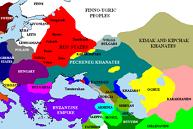
1015 The Dome of the Rock in Jerusalem collapses after an earthquake, and is rebuilt in 1022; another earthquake in 1016 damages jerusalem and Jaffa. On July 15 Vladimir I the Saint (b. 858) dies after being crowned grand prince of Rus on June 11 (sad that Jeezy didn't come?), and his son Sviatopolk I (the Accursed) (980-1019) becomes king of Kiev (until 1019); his brothers Yaroslav I (978-1054), Mstislav (-1036), Boris (-1015), and Gleb (-1015) begin a war for the throne (ends 1019). Canute returns to England with a large fleet and conquers Wessex. (St.) Olaf II Haraldsson (995-1030) becomes king of Norway (until 1028), and restores Norwegian independence from the Danes, along with Christianity, ending up as Norway's patron saint - good morning angels; good morning Olaf? The Arabs conquer Sardinia. The Banu Hammad led by the Zirid gov. of E Algeria revolt from the Fatimids, and found the Hammadid Dynasty in C and E Algeria (ends 1152). Malcolm II takes advantage of the death of Jarl Sigurd the Once Mighty of Orkney to help his young grandson (Sigurd's successor) Thorfinn (the Mighty) Sigurdsson (1009-64). This year and next Ramon Borrell of Barcelona makes expeditions to the Ebro and Segre Rivers, gaining booty to insure the loyalty of his barons, and becomes the first Catalan ruler to mint his own coins. After exploring Long Island, the Hudson River, and possibly Chesapeake Bay, Thorfinn Karlsefni and his Viking settlers return from Vinland to Greenland because of hostile Skraelings (Indians) (Alonquins, probably of the extinct Micmac or Beothuk tribe?) and/or the problem of too few white women (or vice-versa?); did some of the Norsemen move inland to Ontario? A plague is recorded in Leinster, Ireland. The Slav settlement of Leipzig (Slav "lipsk" = lime/linden/basswood tree) in Saxony at the confluence of the White Eister, Pleisse, and Parthe Rivers at the S end of the North German Plain 99 mi. SW of Berlin (modern-day pop. 582K) (founded before 1000?) is first mentioned as "Urbs Lipzi" in the chronicles of Bishop Thietmar von Mersenburg. The duchy of Burgundy in the NW part of the old Merovingian territory becomes a French Capetian possession (until 1363). Benevento institutes the Communitas, the first municipal self-govt. The Bitola Inscription records info. about Bulgarian tsar Samuel. Architecture: About this time Strasbourg Cathedral de Notre-Dame begins to be built in the pate de foie gras-producing river port of Strasbourg (Strassburg) 2 mi. W of the Rhine River 90 mi N of Basel and 350 mi. SE of Paris (founded by the Romans in the 1st cent. C.E.); Bishop (since 1001) Werner I of Strasbourg lays the first stone. Music: Sight singing is introduced at Pomposa Monastery near Ravenna, Italy. Births: English king (1035-40) Harold Harefoot (d. 1040); son of Canute (-1035) and Aelgifu (995-1040). Deaths: Russian (Kievan) grand prince St. Vladimir I (b. 858) on July 15 in Berestovo.
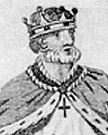

1016 On Mar. 10 emperor (since July 16, 1011) Sanjo (975-1017) abdicates in favor of his 2nd son Go-Ichijo (Atsuhira) (1008-36), who becomes Japanese Yamato emperor #68 (until May 15, 1036). On Mar. 25 (Palm Sun.) after Eirikr Hakonarson joins his brother-in-law Canute the Great in his campaign to conquer England, causing Danish rule to fold, King St. Olav Haraldsson wins the naval Battle of Nesjar in the W end of Oslofjord off the coast of Norway, chasing Svenin Hakonarson back to Sweden and dying before being able to gather a force to retake Norway, becoming the main event of his reign. On Apr. 23 Ethelred II of England (b. 968) dies in London, and Canute, who has captured all of England except London gets a rump Witan to choose him as the new king, while the citizens of London proclaim his son Edmund II (Ironside) (988-1016) as the 15th monarch of England, causing Canute to siege London 2x and fight five battles, first getting defeated at the Battle of Oxford in Kent, then (bearing a cool white silk flag embroidered with a raven) decisively kicking Ironside's ashcan on Oct. 18 at the Battle of Ashingdon (Assandun) (Essendune) in Essex, resulting in the Treaty of Olney, spliting England between them, like in the time of Alfred the Great; on Nov. 30 Edmund (b. 988) dies (murdered with a sword up his ashcan in the lavatory?), leaving Canute as sole ruler of England, ruling from London, his first act being to order the execution of some of the more pesky English chiefs and banish Edmund's two infant sons, Edmund Aetheling (1015-1046), who dies in Wessex, and Edward Aetheling the Exile (1016-57), who is sent to the court of King Olof Skotkonung in Sweden and ordered murdered, but lucks out and gets secretly sent to Kiev, ending up in Hungary, then recalled to England by Edward the Confessor and made his heir. Gabriel Radomir (b. 970) is murdered by his cousin, and John (Ivan) Vladislav (Ladislaus) (-1018) becomes Bulgarian tsar (until Feb. 1018), continuing the doomed war against the Byzantines; meanwhile the Byzantines ally with Mstislav of Chernigov and invade the Crimea, then capture Khazar warlord (Jewish?) George (Georgius) Tzul (based in Kerch), giving them control of the S Crimea. Berber caliph Sulayman II al-Mustain is deposed and executed in Cordoba by a Berber gen. - what Kingdom of Cordoba? In Tunisia Sunnis, mainly in urban areas riot against Shiite control of the state (ends 1017). The new Drano Family of Italy? After his brother Osmond Drengot (985-1018) is exiled by Richard I of Normandy for murdering his relative William Repostel in revenge for sleeping with one of his daughters, and Rainulf (Ranulf) Drengot (de Quarrel) (-1045) accompanies him along with other brothers Gilbert Buatere Drengot (985-1018), Asclettin Drengot, 1st Count of Acerenza, and Rudolph (Ralph) Drengot, plus 250 Norman warriors to S Italy on a pilgrimage to the shrine of St. Michael the Archangel in Mount Gargano in Apulia, where they set up a fort and join forces with Melus of Bari, becoming anti-Byzantine mercenaries (until 1030). Like Thorkel in 1012, Canute makes his Danegeld payment to Ulf, father of Karsi and Gerbjorn, which is recorded on the Borrestad Memorial Stone at Yttergarde, Uppland, Sweden. Anselan Okyan, king of S Ulster arrives in Scotland at Argyllshire, and is put in the service of the king against the Danes, becoming the first lord of Buchanan on Loch Lomondside. Births: Polish Piast duke (1040-58) Casimir (Casimire) (Kazimierz) (Kazimir) (Slav. "bringing peace") I (the Restorer) (d. 1058) on July 25 in Crakow; son of Mieskzo II (990-1934) and Richensa of Lotharingia (995-1063) (granddaughter of HRE Otto I); father of Boleslaus II the Bold (1038-81). German Salian king #2 (1028-56) and HRE (1046-56) Henry III (the Black) (the Pious) (d. 1056) on Oct. 28; eldest son of Conrad II (990-1930) and Gisela of Swabia (995-1043). English heir apparent Edward Aetheling (the Exile) (d. 1057); son of Edmund II Ironside (988-1016) and Ealdgyth. Hungarian Arpad king (1061-3) Bela I (d. 1063); 3rd son of Duke Vazul (-1037); younger brother of Andras I (1014-61). Norwegian king (1046-66) Harald III Hardrada (Haardraade) (Norse "hard ruler") Sigurdsson (d. 1066). Norman adventurer Robert Guiscard (Lat. "the Fox"), Duke of Apulia (d. 1085); brother of Roger Guiiscard; husband (1058-) of Sikelgaita of Lombardy (1040-90); father of Bohemund I de Hauteville (1058-1111), Roger Guiscard, and Roger Borsa (1060-1111). Indian Buddhist master Naropa (d. 1100). Deaths: Indian philosopher Abhinavagupta (b. 950) in Mangam, Kashmir; leaves Tantraloka (Sansk. "Light on Tantra"). English king (978-1016) Ethelred II (b. 968) on Apr. 23 in London. English king (1016) Edmund II Ironside (b. 988) on Nov. 30 in London (Oxford?); Canute's agents hide beneath a lavatory and thrust a sword up his arse, assassinating him?
1017 In Jan. the Witan acknowledges Canute (Cnut) the Great (995-1035) as king of all England (16th English monarch) (until 1035); he divides his kingdom into four earldoms: Northumbria (Northumberland) (north), East Anglia (east), Mercia (central) and Wessex (south); he then does a chameleon act and goes from a mean to a nice guy, marrying Emma of Normandy, widow of Ethelred II the Unready (he's Eveready II?), and becomes a (Greek?) Christian, giving himself the title of Basileus, and never wearing his crown but instead hanging it on the head of a Christ on a crucifix (according to Henry of Huntingdon), and once ordering the sea back but getting his feet wet, saying "Let all men know how empty and worthless is the power of kings, for there is none worthy of the name but He whom heaven, earth and sea obey by eternal laws"; he chooses Danes as earls for the first three, but picks Saxon supporter Godwin (1001-53) for earl of Wessex; not wanting to play the conqueror, he sends his army home, keeping only a 3K-4K-man bodyguard known as the housecarles, and restores peace and prosperity to Merry Ole England; "Merry sang the monks at Ely as Cnut the king rowed by"; during Canute reign, the seaport of Bristol in W England becomes a center for the Irish wool trade - I like a good piece of what? In May after Melus of Bari, backed by the Norman force of Rainulf Drengot invades Apulia in a surprise attack, they defeat the Byzantine forces of new catapan Leo Tornikios Kontoleon on the Fortore River at Arenula, seize all the territory to the Trani River by Sept., and ravage Apulia while kicking Kontoleon's can in Civita and again at Vaccaricia (future site of Troia), causing him to be canned in Sept. in favor of Basil III Boioannes (-1027) (AKA Bugiano), who is appointed by emperor Basil II in Dec., proving to be much tougher, immediately requesting Varangian Guards from Constantinople to fight insurgent Lombard Gen. Melus of Bari and his Norman mercenaries and going on to reestablish the Byzantines as a major force in S Italy after cents. of decline. Henry II loses his struggle (begun 1003) with Boleslav I over Lusatia and Silesia. After returning to Constantinople for a triumph over his Crimean Vs, Basil II heads E and attacks the Persians over control of Armenia (a Byzantine tributary since 1000). Raymond Borrell (b. 972) dies, and his son Berenguer Ramon I (the Crooked) (the Hunchback) (1005-35) becomes count of Barcelona, Girona, and Ausona (until 1035), with his mother Ermesinde as regent (until 1023), who goes on to continue to rule with him as an adult, proving far more eager to go after pesky Muslims. Alfonso V and his wife Elvira (Geloria) Mendes grant the first franchises of Leon. Rajendra Choladeva finishes conquering Ceylon (begun 1014), this time taking the throne of Pandya. Births: Spanish king of Castile and Leon (1037-65) and all Spain (1056-65) Ferdinand I (the Great) (d. 1065); son of Sancho III of Navarre (-1035). Italian marchioness Beatrice (Beatrix) of Bar (d. 1076); daughter of Duke Frederick II of Upper Lorraine (995-1026) and Matilda of Swabia; wife (1037-52) of Boniface III of Tuscany (985-1052) and Duke Godfrey of Lower Lorraine (997-1069); mother of Matilda of Tuscany (1046-1115). Greek Byzantine Platonist philosopher Michael Psellos (Psellus) (d. 1079). Deaths: Japanese Buddhist priest-theologian Eshin Sozu (b. 942); leaves Collection on the Essentials for Attaining Birth (Ojo Yo Shu). Spanish count of Barcelona (992-1017) Ramon Borrell (b. 972).
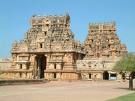
1018 On Jan. 30 the war between Germany and Poland over control of Lusatia, Upper Lusatia, E Meissen, Bohemia, Morari, and Slovakia(begun 1004) ends with the Treaty of Bautzen, whereby Boleslav I gives up Bohemia but keeps Lusatia as an imperial fief, making Poland one of the strongest states of Europe; Boleslav I conquers part of Prussia and converts some of the tribes, but the main body stays proudly pagan until the 1230s. In Feb. the Byzantines under Basil II the Bulgar Slayer finish off the last pesky Bulgarians at the Second Battle of Dyrrhachium (modern-day Durazzo or Durres) on the Albanian coast, killing John Vladislav, who only has young sons, causing the Bulgar leaders to throw in the towel; Byzantium regains Macedonia, and incorporates Bulgaria into the empire, with themes (governors) in Bulgaria and Paristrium, ending the First Bulgarian Empire; for the next 168 years Bulgaria is integrated into the Byzantine Empire (until 1185); the Bulgarian patriarchate is abolished, but the archbishop of Okhrid retains autonomy; the Bulgarian aristocracy moves to Constantinople and merges into the leading Greek families; the Byzantines restore their ancient Danube River for the first time in four cents.; Big Man Basil II celebrates a triumph in Athens before returning to Constantinople. On Oct. 1 the Second Battle of Cannae on the Ofanto River near Cannae in SE Italy (site of Hannibal's big V in 216 B.C.E.) is a V for the Byzantines under gen. Basil III Boioannes over the rebel Lombards of Melus of Bari and his 250 Norman knight allies, reestablishing the Byzantines in S Italy; Rainulf Drengot's brothers Gilbert and Osmond are KIA, and only 10 Normans survive; Melus flees back to Amatus in the papal territory, while his son Dattus flees back to his tower; Boioannes goes on to build a fortress in the Appenines guarding the entrance to Apulia, and garrison Troia with his own Norman troops, obtaining the submission of all of the Mezzogiorno except the duchy of Benevento, which remains faithful to the pope; meanwhile Melus ends up wandering to the court of Henry II in Bamberg, Germany, where he is given the title of duke of Apulia, and Rainulf withdraws to Campania, where he plays both ends against the middle for mercenary money, "never desiring any of the Lombards to win a decisive victory, in case this should be to his own disadvantage, but by supporting one side and then the other, he prevented anyone being completely ruined". Malcolm II of Alba (Scotland), allied with King Owen (Ywain) the Bald of Strathclyde defeats the Northumbrian Saxons at the Battle of Carham on the Tweed River, confirming his absorption of the Anglo-Saxon district of Lothian N of the Tweed, leaving only Strathclyde, whose king soon dies from wounds received in the battle, allowing him to absorb it too, dividing mainland Britain into two major monarchies - now if they can just keep it that way? Canute levies a heavy Danegeld on England which he uses to pay off his Danish warriors; meanwhile his brother King Harald of Denmark dies, and he goes to secure his hold over that kingdom, becoming king of both England and Denmark; England's 16th king becomes its first emperor, with a great northern empire rivaling the HRE; the Council of Oxford is held, and Canute confirms the laws of Edgar - Copenhagen, Anglia, come on pretty momma? Henry I dies, and Adalbert the Victorious (985-1055) becomes margrave of Austria (until May 26, 1055). Holland on the North Sea coast becomes independent of Lorraine, with its own count. The Muslims invade India; the sacred Indian city of Muttra (Mathura) in Uttar Pradesh (31 N of Agra and 90 mi. SE of Delhi) (birthplace of Krishna) is pillaged by Mahmud of Ghazni - don't touch my muttra? The Khitans of Manchuria invade Koryo (Korea) for the 3rd time since 993, and are bloodily repulsed. Heribert (970-1021) becomes archbishop of Milan, setting up the carroccio (arc of municipal patriotism), expanding Milan's power on the Lombard plain. Architecture: The Brihadisvara (Bridadisvara) Rasvamin Temple in Tangore, India is built. Births: Danish king (1040-2) and English king (1040-2) Hardicanute (Harthacanut) (Dan. "tough knot") (Canute III) (d. 1042) in England (not to be confused with Tippecanoe and Tyler too?); son of Canute (995-1035) and Emma of Normandy. Georgian Bagrationi king (1027-72) Bagrat IV (d. 1072); son of George I (998-1027) and 1st wife Mariam of Vaspurakan. Seljuk statesman-writer Nizam al-Mulk (d. 1092). Deaths: Spanish count of Barcelona (992-1017) Raymond Borrel (b. 972). German bishop-chronicler Thietmar of Merseburg (b. 975) on Dec. 1. Scottish (Strathclyde) king Owen (Ywain) the Bald in Carham (KIA).

1019 Vladimir I's son Yaroslav (Jaroslav) (Russ. "beauty of spring") I (the Wise) (978-1054) becomes the most powerful grand prince of Kiev so far, and begins building Russia up and codifying its laws, promulgating the first written code (under Byzantine influence), the Russkaya Pravda (Russian Truth); his last surviving brother Mstislav of Chernigov (-1036) is given the territory E of the Dnieper River until his death. Armenia is first invaded by the Turks; "The first appearance of the bloodthirsty beasts... the savage nation of infidels called Turks entered Armenia... and mercilessly slaughtered the Christian faithful with the sword (Matthew of Edessa). Nonfiction: Anon., Life of St. Goueznou. Births: Indian mathematician-astronomer-astrologer Sripati (d. 1066). Chinese scholar, statesman, and #1 historian Ssu-ma Kuang (Sima Guang) (d. 1086) in Yucheng, Shanxi.